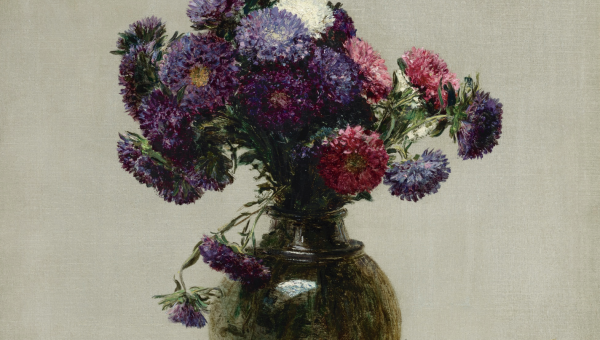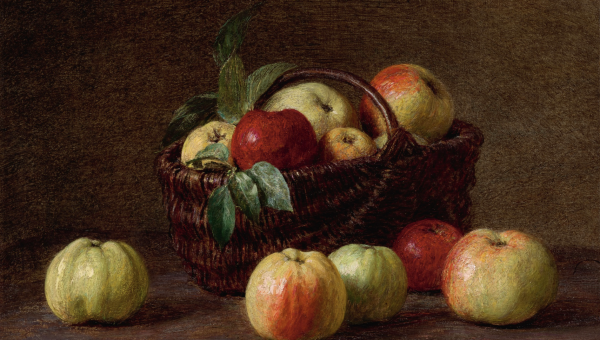OLD MASTER EVENING SALE
On the evening of January 30th, Sotheby’s New York will be offering a collection of works by female artists from the 16th-19th centuries as part of their old master evening sale.
Among these works is an Angelika Kauffmann, R.A. (COIRA 1741-1807 ROME), Portrait of Three Children, almost certainly Lady Georgiana Spencer, Later Duchess of Devonshire, Lady Henrietta Spencer and George Viscount Althorp.
The Fine Art Group is proud to represent the collection this Kauffmann comes from, which can be viewed as a single owner sale from January 25th to February 1st at Sotheby’s in New York.
Featuring Highlights from The Female Triumphant
Including Masterworks by Rosa Bonheur, Virginie Demont-Breton and Elizabeth Gardner Bouguereau
10 Works by William Bouguereau
Led by Le livre de prix, Unseen on the Market for Over a Century
Exceptional Victorian & British Paintings
Including Works by Sir Lawrence Alma-Tadema and John Atkinson Grimshaw

Elizabeth Jane Gardner Bouguereau
Le captive
Estimate: $250,000-$350,000
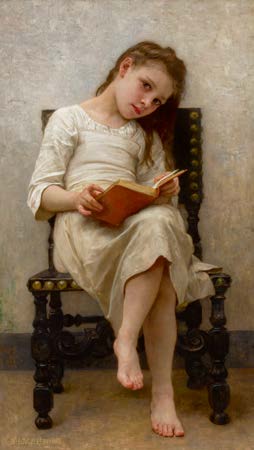
William Bouguereau
Le livre de prix
Estimate: $1-$1.5 million
SOTHEBY’S MASTERS WEEK EXHIBITION
OPEN TO THE PUBLIC ON JANUARY 25, 2019
New York, January 18, 2019
Sotheby’s auction of 19th Century European Art on 1 February 2019 will present over 200 works that reflect the rich diversity of artistic production of the period. Paintings by Rosa Bonheur, Virginie Demont-Breton and Elizabeth Gardner Bouguereau are among the highlights from The Female Triumphant – a group of masterworks by trailblazing female artists from the 16th through the 19th centuries, which will be offered across our Masters Week sales this January. The sale is further distinguished by William Bouguereau and Jules Breton’s portraits of rural life, Sir Lawrence Alma-Tadema and John William Godward’s epic visions on the Ancient world, and Pascal Adolphe Jean Dagnan-Bouveret and Jean Béraud’s views of life in the Belle Époque – many of which are from private collections and resurfacing at auction for the first time in over a century.
Open to the public on 25 January, the sale will be presented alongside Sotheby’s Masters Week exhibitions.
THE FEMALE TRIUMPHANT: WOMEN ARTISTS OF THE PREMODERN ERA

Rosa Bonheur
Le Labourage
Estimate: $80,000-$120,000
In the late nineteenth century, Paris invited innovation, experimentation and boundary breaking, yet the advancements made by women artists in the public sphere were met with challenges. Thanks to their irrefutable talent and perseverance, women certainly found success, as illustrated in the vital careers of the artists featured in The Female Triumphant, including Rosa Bonheur, Virginie Demont-Breton and Elizabeth Gardner Bouguereau.
A precocious talent from a young age, Rosa Bonheur first exhibited at the Salon in 1841. Four years later, she presented Le labourage, and earned a third place medal for its characteristically meticulous craftsmanship and photographic realism (above, estimate $80/120,000). Her achievement not only cemented her as a success, but led to further commissions and ultimately the
French Légion d’honneur, which was presented to her in 1865 and marked the first time a woman received the honor.
Elizabeth Gardner Bouguereau was one of the most accomplished Salon artists among expatriates in mid-nineteenth century Paris and in 1887 had the distinction of becoming the only American woman to receive a Salon medal. In addition, Gardner’s personal and professional attachment to her husband William Bouguereau was instrumental in establishing her style and in marketing her work such as La captive, exhibited at the Salon of 1883 (front page, estimate $250/350,000), and Les trois amis (estimate $250/350,000).
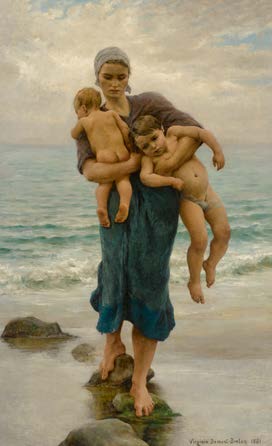
Virginie Demont-Breton
Femme de pêcheur venant de baigner ses enfants
Estimate: $100,000-$150,000
Virginie Demont-Breton enjoyed an artistic upbringing and cultivated her talent from an early age, having trained under her father, Jules Breton, who work is also represented in the auction. Winning Demont-Breton’s first medal at the Salon of 1881, Femme de pêcheur venant de baigner ses enfants is the artist’s earliest masterpiece, propelling her distinguished career as a painter and as a pioneering advocate for women artists (estimate $100/150,000). In 1894, Demont-Breton was the second woman in France to be awarded the Légion d’honneur and from 1895-1901 served as the president of the Union des Femmes Peintres et Sculpteurs where she was instrumental in the fight to grant women entrance to Paris’ École des Beaux Arts.
WILLIAM BOUGUEREAU: MASTER OF FRENCH ACADEMIC PAINTING

William Bougereau
Bacchante
Estimate: $600,000-$800,000
A selection of 10 works by William Bouguereau will be highlighted by Le livre de prix, one of the finest canvases of the artist’s mature period to come to auction (front page, estimate $1/1.5 million). The young girl in the present work is Yvonne, one of the artist’s favorite models, who appears in many of Bouguereau’s compositions from 1893. Formerly in the collection of Henry May, Vice President and General Manager of the Pierce-Arrow Motor Company, the work has remained in the same family’s collection for over 100 years. Known only through a black and white photograph from Bouguereau’s studio, its presentation today marks an important and long-awaited rediscovery.
Also featured in the January sale is Bacchante from 1894 (above, estimate $600/800,000). The painting was likely inspired by the mythological subjects favored by many nineteenth century artists, including Bouguereau’s English contemporaries Sir Lawrence Alma-Tadema and John William Godward. The woman in the present work, a Dionysian devotee, belongs to a series the artist referred to as “fantasy paintings,” a theme that the artist established through earlier works that illustrate Classical narratives.
JULES BRETON: THE PAINTER OF PEASANTS

Jules Breton
Le Matin
Estimate: $400,000-$600,000
The January sale features four exceptional works spanning three decades of Jules Breton’s career. La Glaneuse is a recent discovery, compelling a renewed appreciation of the pivotal production of the self-proclaimed “painter of peasants’” early oeuvre (estimate $150/200,000). Known for his Realist, rural landscapes populated by shepherdesses, harvesters and gleaners, the atmospheric tour-de-force of Le Matin (above, estimate $400/600,00) received widespread admiration upon its exhibition at the Salon of 1883, while La Falaise’s enigmatic subject of a peasant girl looking out to sea has captivated audiences since the late 1870s (estimate $200/300,000).
VICTORIAN & BRITISH PAINTINGS
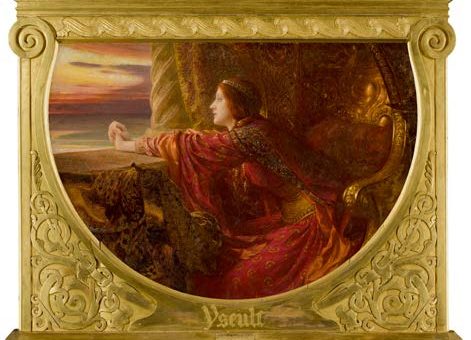
Sir Frank Dicksee P.R.A.
Yseult
Estimate: $1,000,000-$2,000,000
Featured on the sale’s catalogue cover is Sir Frank Dicksee’s Yseult, which the artist presented at the Royal Academy in 1901 (below, estimate $1/2 million). Inspired by Sir Thomas Malory’s Le Morte d’Arthur, the painting depicts Princess Yseult of the White Hands, the wife of Sir Tristram, who gazes out of her window looking for a ship on the horizon.
Female beauty would always be an important element of Dicksee’s paintings and his gorgeously decorative single-figure subjects like the present work are among his most celebrated pictures.
Completed in 1922, A Dilettante by John William Godward marks an important rediscovery for the artist, reappearing for the first time in nearly a century (estimate $400/600,000). Regarded as one of his last great paintings, A Dilettante demonstrates Godward’s painstaking attention to detail and depicts the artist’s vision of idyllic Antiquity.
Painted in 1894, Sir Lawrence Alma-Tadema’s jewel-like Past and Present Generations embodies the artist’s connection to the antique subjects which he cherished (right, estimate $300/500,000). In addition to painting subtle narratives with emotional depth, Alma-Tadema was known for his diligent sourcing of historical references, such as the marble Roman funerary busts of the balustrade, which are based on precise drawings Alma-Tadema made in the Uffizi in Florence and the Capitoline Museum in Rome.
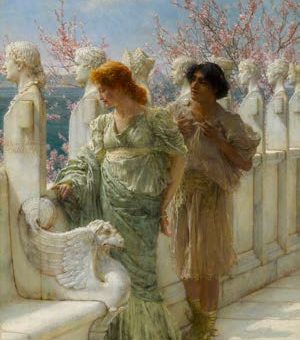
Sir Lawrence Alma-Tadema, O.M., R.A.
Past and Present Generations
Estimate: $300,000-$500,000
The auction also offers an extraordinary oil painting by the great English Victorian-era artist John Atkinson Grimshaw. A prime example of the artist’s trademark street scenes throughout the 1880s, A November Morning, exhibits the hallmarks of Grimshaw’s mature style, and his atmospheric depiction of the evening and the first light of the morning (Estimate: $200,000-$300,000).
Among the selection of outstanding maritime paintings to be offered is Fresh Winds, High Seas by British artist Montague Dawson (Estimate: $200,000-$300,000).
Sailing on the white-capped ocean, with its sails fully unfurled, the sea spray and sunlight tangible, the monumental canvas of the racing clipper is being offered by The Saint Louis Art Museum To Benefit Future Acquisitions.
PART II OF OUR SERIES: ARE YOU A TANGIBLE ASSET FIDUCIARY?
Buying a piece of art may not necessarily be a wise investment – and that’s normally because of a lack of due diligence. It can mean the difference between a favorable return and waving goodbye to every dollar you spent on the piece.
due dil·i·gence
- Reasonable steps taken by a person in order to satisfy a legal requirement, especially in buying or selling something.
- A comprehensive appraisal of a business undertaken by a prospective buyer, especially to establish its assets and liabilities and evaluate its commercial potential.
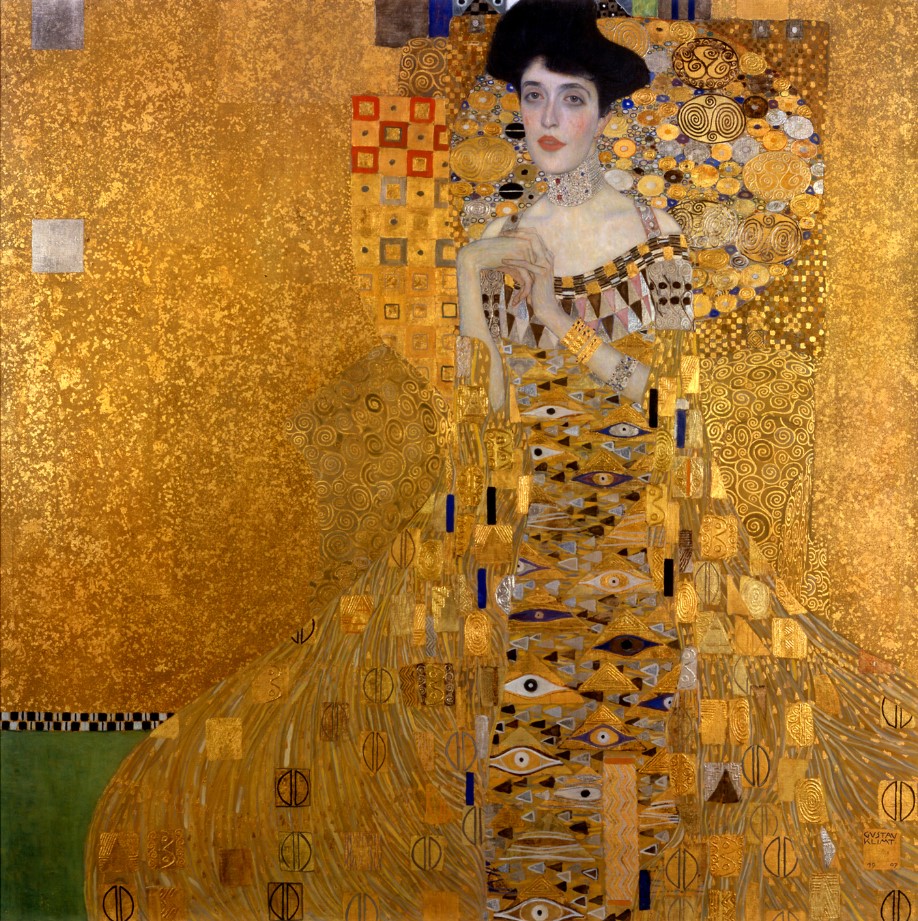
There are many aspects to consider when you are buying a piece of art that are summarized below:
Provenance and Title are first and foremost when it comes to purchasing a piece. One needs to take every precaution to check that a work was not forged, looted, stolen, promised to an institution or even fake. Opinions of authenticity are crucial to the art market— purchasers want to know they’re buying the genuine article and everyone benefits from weeding out fakes. Reputation is everything in the art world and its very foundations are shaken every time a fake work is presented.
Most works of art preceding the 1900s are recorded on the Art Loss Register, which is an International database that captures information about lost and stolen art and antiques. Most people in the art world refer to this database whenever buying a work of art to ascertain if the piece has previously been looted and offered up for sale without the prior owner’s knowledge. There have been many court cases involving works of art that were looted during World War II – these pieces came up in the art world many years later and the original owner of the work has the right to claim their possessions back in court.
Catalogue Raisonné is a comprehensive, annotated listing of all the known artworks by an artist either in a particular medium or all media. Most of the works would have a reference number by each work and listing of provenance, which helps people track a painting for authentication and ownership. However, sometimes the information is very old where the works have been sold or not recorded so there is a chance there can be gaps in a piece’s timeline due to lack of available research.
Antiquities is one of the trickiest areas to conduct due diligence. Provenance and title for these pieces can be misleading, as the work can be from hundreds of years ago where there were no records of authentication or ownership.
Many artists from the Impressionist and Post War era have foundations that receive hundreds of requests for confirmation of authenticity from galleries, auction houses and collectors. The authentication process can sometimes be a lengthy process, which must be considered.
So, once you have bought a piece of art, what can stop you receiving it?
SHIPPING DELAYS AND SEIZURES
When shipping reproductions of artworks such as antiquities. Customs can halt clearance, should they wish to see further documentation to prove that the work is, in fact, a reproduction and not the real work masquerading as a reproduction. If you cannot provide this, there is a chance that they will never release the piece to you without the relevant documentation.
MATERIALS USED
When buying a piece, the materials used must be considered. For example, there is a Damien Hirst painting consisting of paint and an array of butterflies. It’s important to know that when shipping the work to certain countries you would need to retain a list of the exact species the artist used. This is referred to as CITES, which is the Convention on International Trade in Endangered Species of Wild Fauna and Flora. It’s an international agreement between governments and its aim is to ensure that international trade in specimens of wild animals and plants does not threaten their survival. Customs will not clear the works of art unless they have this list.
BANNED MATERIALS
Materials such as ivory cannot be shipped in and out of specific countries. The US set up the UNESCO Treaty that protects the trafficking of cultural property. Ivory is a protected element, along with tortoiseshell. So, it’s important to check if a piece contains materials of this nature. In certain cases, sales are exempt from this ban, i.e. if the material was imported before the ban in 1989 and authenticated by a government-issued permit, or the material is older than a century.
A known example here is a Parisian client who bought a handbag from the Elizabeth Taylor auction in New York at Christies. The client was unable to have the work sent to her in Paris as it contained pieces of ivory. The client did not consider this before winning the bid and she lost her investment.
CULTURAL HERITAGE
Many countries have their own laws on cultural heritage. For example, a dealer in France was asked to sell an item of jewelry originating from Marie Antoinette. This sale never happened due to the item being part of France’s Cultural Heritage.
Purchasing a piece from Italy that’s more than 50 years old requires its own passport for shipping to another country. This is something to be aware of if one is in a rush to sell or buy a work.
DELIVERY OF INSTALLATION PIECES: PERMITS AND TRANSPORT
When buying a more complex work such as a sculpture or installation, many aspects must be considered regarding the size and fragility of the piece.
In some instances, if living in a property in busy cities such as Manhattan, you may have to apply for a permit to have it delivered, particularly if it needs to be lifted via crane to go in through a window. Traffic may be affected during delivery and this needs to be taken into account.
Transport is also incredibly important especially when shipping long distance. Every measure needs to be taken to ensure safe delivery without loss or damage. Be sure to use a trusted art transport company and installation company whenever possible. Whilst it may be costly, these experts are adept at maneuvering and positioning the piece correctly. This is particularly important when it comes to outdoor sculptures or moving it through narrow hallways and up and down stairs.
TAXES
Protect yourself from the shock of hefty additional charges by researching import and export taxes if shipping out of the US.
Also, be aware of State Taxes that may be applied to your purchase depending on where you live. For example, New York will have % State Sales Tax added to their final purchase price.
PROTECTING YOURSELF AND YOUR MONEY
Buying and selling at an auction house or through a reputable dealer and or advisor can be one of the best ways to protect yourself, as it’s common practice for them to do extensive due diligence on provenance and authenticity. These houses and dealers have tried and tested ways of investigating the history of a piece and maintaining their reputation for handling genuine items is essential for their business. Whilst there is no guarantee, it’s by far the best piece of mind to use these long-established businesses.
So, develop relationships with experts such as galleries, auction houses, and trusted advisors. Buying with confidence can be tricky in the art world but doing as much due diligence as possible should protect you and your investment. The older the work, the more difficult it can be to verify authenticity, so be sure to obtain legitimate paperwork whenever possible. Though it may not always be available to you, it’s the best way to ascertain the authenticity of a piece and will ensure a much easier future sale, should you wish to part with it.
Due diligence forms an essential part of any art purchase. Investigating and obtaining as much information as possible about the sellers and the artwork can protect collectors from making terrible investments.
It is recommended that a third party or independent entity such as The Fine Art Group should review purchases first to make sure all the i’s are dotted and t’s crossed. We wish you only shrewd investments and would be happy to answer any questions you may have regarding this article.
One of the essentials of being a tangible asset fiduciary as it relates to valuation is two part. One, is there a clear understanding of the value of the tangible assets? Two, is the value being applied to objects reflective of the strategies.
What is a Tangible Asset Fiduciary?
The word Fiduciary evolved out of the Latin Fidere, to trust. In order to truly act on behalf of a client’s interest trust needs to be the bedrock of the relationship. A tangible asset fiduciary has no “skin in the game”; the focus of our work is the valuable objects in a client’s collection. Our approach is independency and transparency. This essentially means that every action we take and every strategy we propose is directly in the best interest on the objects and the clients that own them. The client trusts us to represent them.
TOPIC #2: INDEPENDENCE AS THE FOUNDATION OF VALUATION
St. George’s Kermis With the Dance Around the Maypole” (1627), by Pieter Bruegel the Younger. Appraised by Sotheby’s for estate tax purposes in 2005 for $500,000; Sold at Sotheby’s in 2009 for $2.1 million.
When is an appraisal needed?
Whether it is for purchase, sale, estate planning, probate, divorce, rental lease back, fractional interest, insurance or donation, a correct appraisal is needed for any tangible asset. The methodology will directly reflect the overall goal of the valuation. Looking at one object as an example, you can track the different values depending on the purpose.
CASE STUDY
Mr. Smith has decided that he wants to acquire a Milton Avery painting from a gallery in New York City. He contacts The Fine Art Group to obtain a market analysis so that he can negotiate correctly with the gallery. The market analysis reveals that the work sold previously at auction for $200,000 in 2007. As the Milton Avery market has increased in value for the right subject matter and year, his Fine Art Group advisor recommends paying no more than $300,000 for the painting. He purchases the painting at $300,000.
Mr. Smith needs to add the painting to his insurance. As he purchased from a gallery in NYC, his insurance value will be the receipt from the gallery plus tax and shipping. The total cost with expenses was $330,000, which is the retail replacement value.
Mr. Smith decides he would like the portfolio value or estate planning value to begin strategizing with his financial advisor and accountant. The portfolio value is the fair market value. In the current auction market with premium, the Milton Avery would sell for $250,000. This is the value he can use for rental lease back, fractional interest, divorce, estate planning or donation.
Eventually Mr. Smith is interested in using the painting as collateral. The value most appropriate for collateral is marketable cash value which is the auction price minus fees. For the Milton Avery the MCV would be $200,000.
To summarize in this example:
The recommended purchase price was $300,000
The retail replacement value was $330,000
The fair market value price was $250,000
The marketable cash value was $200,000
When the values of the works of art are even more significant, this price differential can be very substantial.
Who does appraisals?
Independence is the key to accuracy.
Appraisals are done by auction houses, dealers, and appraisers. To be a tangible asset fiduciary, it is essential that the valuation should only be conducted by an appraisal firm. While a free-lance appraiser have the knowledge of the piece, frequently individual appraisers do not carry the appropriate liability insurance or insurance to cover damage to an important work of art. There is no licensing for appraisers, the only regulations we have are appraisal associations, including the Appraisers Association of America (AAA), International Society of Appraisers (ISA) and the American Society of Appraisers (ASA) as well as an exam known as Uniform Standards of Professional Appraisal Practice (USPAP). If an appraiser is not a member of at least one of these organizations and is USPAP compliant, he or she should not be conducting appraisals.
There is an inherent conflict when a valuation is conducted by the auction house that wants to sell your work or the dealer that either hopes to sell your work or substantiate a price that they used to sell you the work you purchased from them.
Auction houses often offer appraisals at discounted rates in order to gain access to material and provide additional services for clients. There are several issues with auction houses appraising, including inherent bias and their lack of knowledge on all the markets for objects. While Auction houses have a strong sense of the auction market, they often lack experience with the primary, retail market and with other values such as marketable cash value. If an auction houses wants to sell an object, or recently sold an object, they have a vetted interest in the value benefiting them. A recent court case found that Sotheby’s had valued a painting too low for estate tax in order to entice the estate to sell the painting with Sotheby’s. The painting did sell with Sotheby’s just months later at more than 3 times the estate appraisal value. “Judge Joseph H. Gale ruled instead that the expert had most likely placed a “lowball” estimate on that painting and a second work so as to “curry favor” with the owner, an estate facing a potentially large tax bill, and thus win the business of selling the works at auction.” It should be noted that the IRS art panel strictly follows USPAP and both state that an appraiser is prohibited from appraising an item if they have been involved in the sale of the item.
Similarly, dealers and galleries lack the knowledge and independence that appraisers have, often appraising works of art for substantially higher values than what the client paid. Yearly, complimentary appraisals by the dealers that sold works the works to the owner, often inflate values in order to prove to client’s that their purchase was a good investment. We see this regularly when reviewing insurance schedules that show a yearly increase in the value of the object with appraisals directly from the place of purchase.
Appraisals are a beneficial tool for financial planning, insurance and investment. However, in order to truly be a tangible asset fiduciary, the correct values must be determined by an independent appraisal firm.
FANTASTIC SELL THROUGH RATE OF IMPORTANT JEWELRY COLLECTION
Doyle was honored to auction jewelry from the Estate of Alyce Kalin of Sarasota, Florida, as a highlight of the sale of Important Jewelry on Wednesday, December 12, 2018 at 10am. A private client, we were thrilled with the spectacular sell-through rate of 56 of 60 sold.
Lot 173
Gold, Platinum, Citrine and Diamond Cuff Bangle Bracelet, Trabert & Hoeffer, Mauboussin, Reflection
14 kt., centering one oval citrine approximately 200.00 cts., flanked by 12 fancy-shaped citrines, tipped by rectangular platinum bands of 114 single-cut diamonds approximately 2.70 cts., signed Trabert & Hoeffer, Mauboussin, Reflection, no. 2128, circa 1940, approximately 90 dwts. gross. Inner circle 6 5/16 inches.
Estimate: $5,000 – $7,000
Sold for $43,750 (includes buyer’s premium)
Henry Dunay
Gold, South Sea Semi-Baroque Cultured Pearl and Diamond Necklace
Sold for $22,500 (with Buyer’s Premium)
Lot 252
Buccellati
Gold, Silver and Diamond Pendant-Brooch
18 kt., the delicate filigree oval brooch centering one old European-cut diamond approximately 1.75 cts., within an openwork garland frame of 24 collet-set old-mine cut diamonds approximately 2.80 cts., accented by rose-cut diamonds, signed Buccellati, Italy, 9G, approximately 6.6 dwts. With signed pouch.
Estimate: $4,000-$6,000
Sold: $9,375 (with Buyer’s Premium)
Lot 380
Henry Dunay
Carved Coral, Gold and Diamond Necklace and Bracelet
18 kt., the necklace composed of 31 carved coral beads of floral detail approximately 21.0 to 10.8 mm., bisected by textured gold rings, centering three bombé rings pavé-set with round diamonds approximately 3.00 cts., the bracelet composed of 15 carved coral beads of similar motif approximately 11.8 to 9.3 mm., both signed Dunay, with maker’s mark, necklace no. D2110, bracelet no. C9923. Lengths 20 1/2 and 8 inches.
Estimate: $6,000-$8,000
Sold: $16,250 (with Buyer’s Premium)
Lot 383
Henry Dunay
Gold, Coral and Diamond Bracelet
18 kt., composed of 7 square coral panels approximately 20.0 x 18.5 mm., spaced by brushed stepped bar links, completed by a brushed three bar clasp spaced by a pavé-set diamond bar approximately .55 ct., signed Dunay, no. D3435, approximately 78 dwts. gross. Length 7 inches.
Estimate: $5,000-$7,000
Sold: $12,500 (with Buyer’s Premium)
Lot 267
Wide White Gold, Invisibly-Set Ruby and Diamond Bracelet
18 kt., centering rows of invisibly-set square-cut rubies approximately 78.25 cts., framed by staggered bands of round diamonds approximately 2.40 cts., approximately 59.5 dwts. gross. Length 7 1/16 inches.
Estimate: $8,000-$12,000
Sold: $23,750 (with Buyer’s Premium)
Henry Dunay
Gold, Peridot and Diamond Curb Link Chain Necklace
Sold: $20,000 (with Buyer’s Premium)
RELATED CONTENT
- Selling Jewelry & Watch Collections
- Watch TFG’s New York Luxury Week 2023 Webinar
- Sales Agency Services: Maximizing Value and Efficiency through Comprehensive Sales Strategies
OUR SERVICES
Offering expert Advisory across sectors, our dedicated Advisory and Sales Agency teams combine strategic insight with transparent advice to guide our clients seamlessly through the market. We always welcome the opportunity to discuss our strategies and services in depth.
SUMMER 2018: AN ART ADVISOR’S ROUND UP OF ART BASEL MIAMI
Roxanne Cohen, Director of Art Advisory, The Fine Art Group, at Art Basel Miami Beach 2018. Leading galleries from North America, Latin America, Europe, Asia and Africa show significant work from the masters of Modern and contemporary art, as well as the new generation of emerging stars.
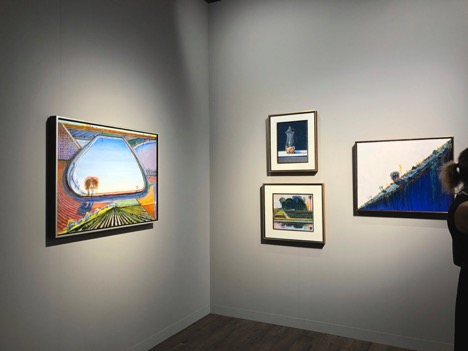
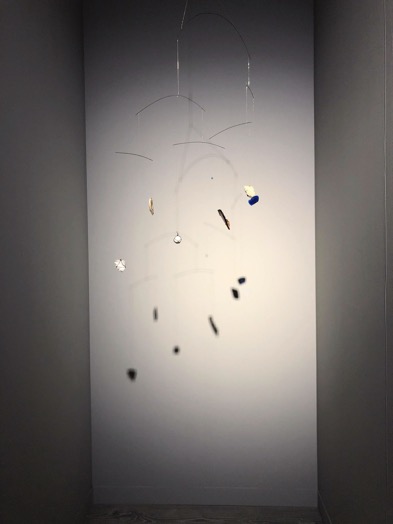


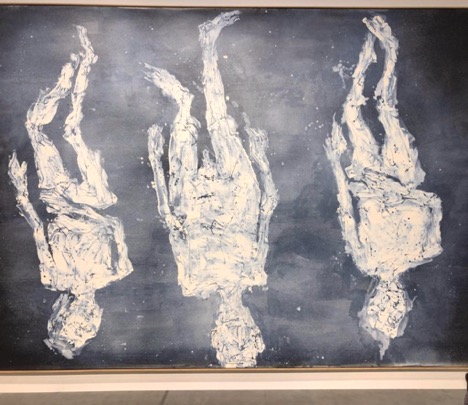
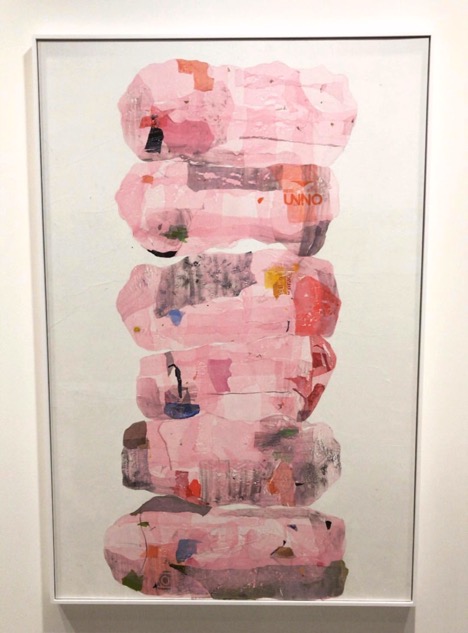
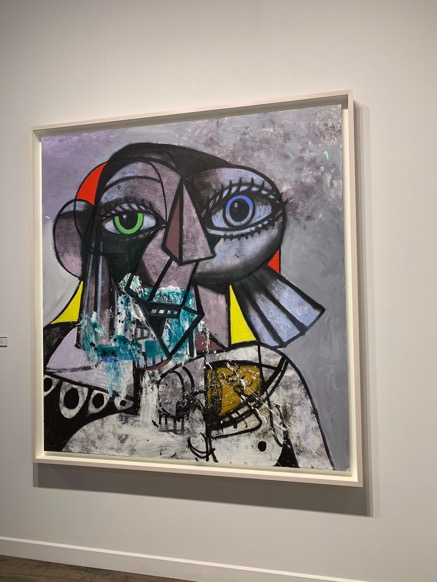
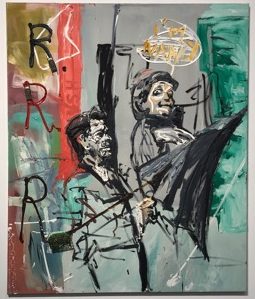
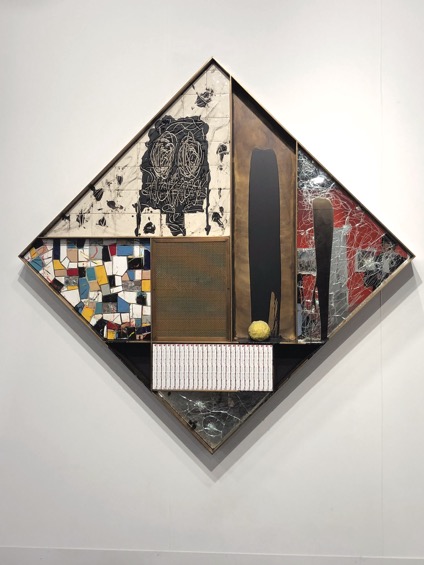
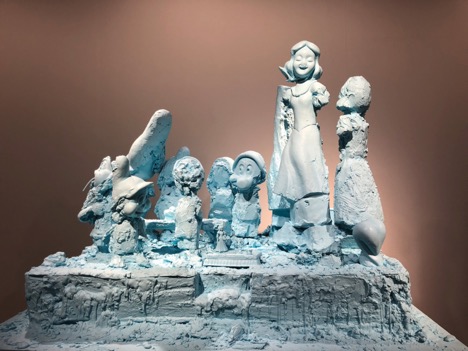
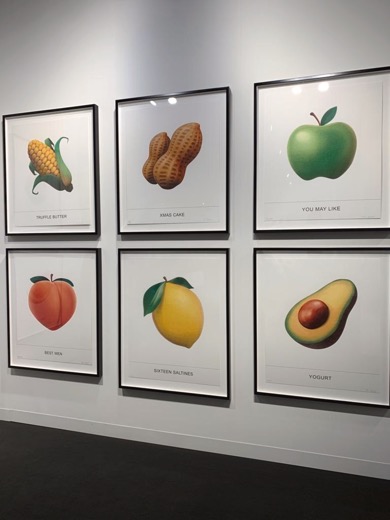



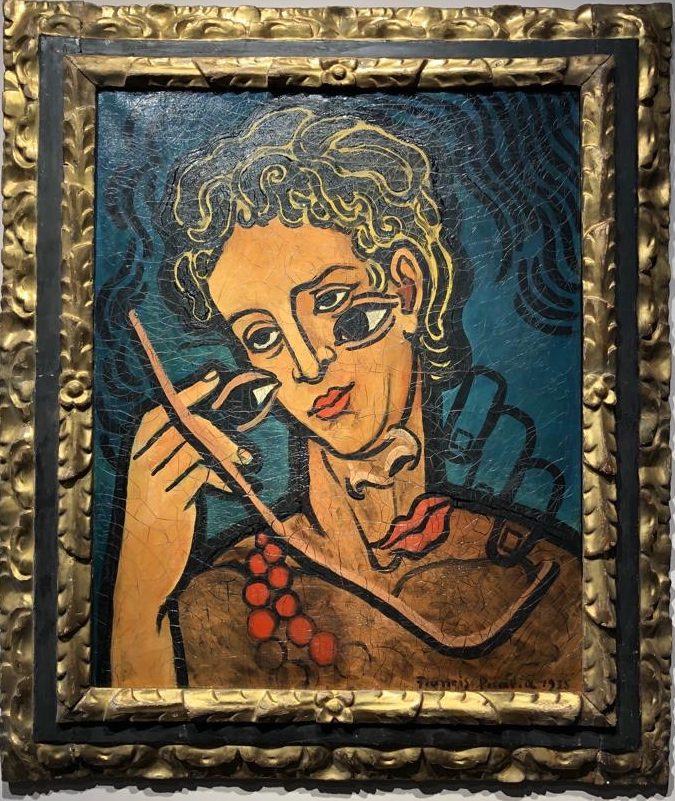
THE REAL & THE IMAGINED: THE AGE OF IMPRESSIONISM
On loan from a Private Collection at the Columbus Museum of Art through September 2019.
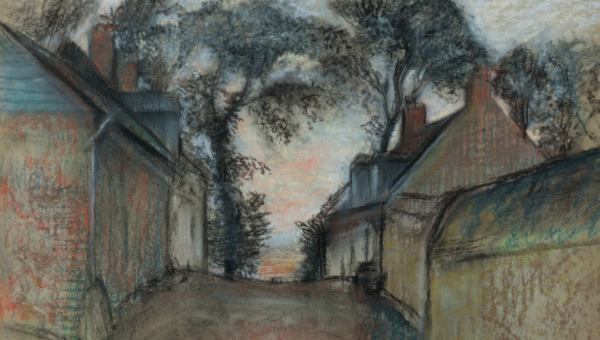
Edgar Degas (French, 1834-1917)
Quesnoy Road, Saint-Valéry-Sur-Somme
1895-1898
Pastel on paper
18 7/8 x 25 1/8 in. (48 x 64 cm)
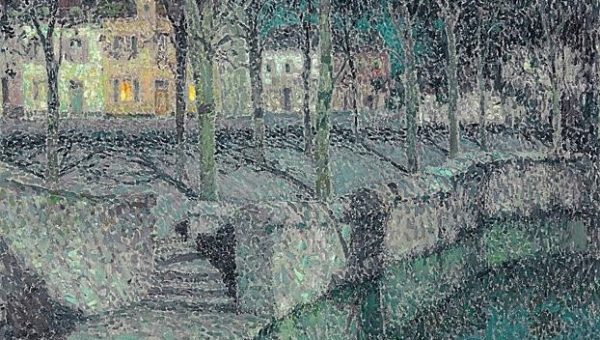
Henri Eugene Augustin Le Sidaner (French, 1862-1939)
The Quay in Moonlight
1920
Oil on canvas
25 3/4 x 31 7/8 in. (65 x 81 cm)

Camille Pissarro (French, 1830-1903)
Goose Girl
c. 1890
Gouache on silk
9 1/4 x 7 1/8 in. (23 x 18 cm)

Auguste Renoir (French, 1841-1919)
View of a Town and Port from a Window
1893
Oil on canvas
9 x 11 3/8 in. (23 x 29 cm)

Henri Rousseau (French, 1844-1910)
View of Billancourt and Bas-Meudon in the Mist
1890
Oil on canvas
8 5/8 x 13 in. (22 x 33 cm)

Maurice de Vlaminck (French, 1876-1958)
Village Square
1918-1919
Oil on canvas
28 3/4 x 36 1/4 in. (73 x 92 cm)
OUR SERVICES
Offering expert Advisory across sectors, our dedicated Advisory and Sales Agency teams combine strategic insight with transparent advice to guide our clients seamlessly through the market. We always welcome the opportunity to discuss our strategies and services in depth.
JOHN SINGER SARGENT AT THE AMERICAN ART FAIR
A private client artwork sold at the 11th Annual American Art Fair held November 10-13th, 2018.
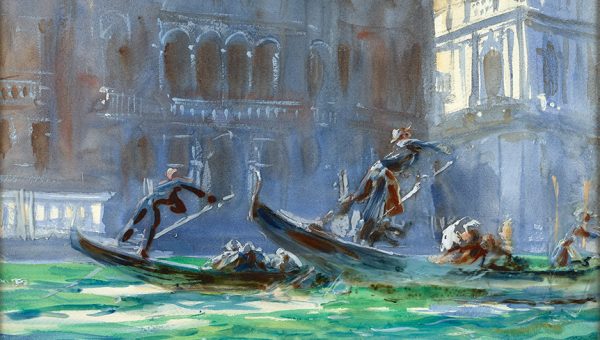
John Singer Sargent (1856-1925)
Festa della Regatta
Oil on glass over watercolor on paper
circa 1903
13 ½ x 19 ½ in.
The gallery’s booth on the 4th floor featured works by George Copeland Ault, George Wesley Bellows, Frank Weston Benson, Albert Bierstadt, William Merritt Chase, Jasper Francis Cropsey, Arthur Garfield Dove, William Michael Harnett, Winslow Homer, Eastman Johnson, Fitz Henry Lane, Robert Laurent, George Benjamin Luks, Thomas Moran, Fairfield Porter, Edward Henry Potthast, and John Singer Sargent, among others.
OUR SERVICES
Offering expert Advisory across sectors, our dedicated Advisory and Sales Agency teams combine strategic insight with transparent advice to guide our clients seamlessly through the market. We always welcome the opportunity to discuss our strategies and services in depth.
Selection of works from the Private Collection of a TFG Client coming up in auction at Sotheby’s – 219 lots across five sales between now and February 2019.
Impressionist & Modern Art Evening Sale,
Sotheby’s New York (2 Lots)
November 12, 2018
Lot 57
Henri Fantin-Latour
Reines Marguerites
Estimate: $700,000-$1,000,000
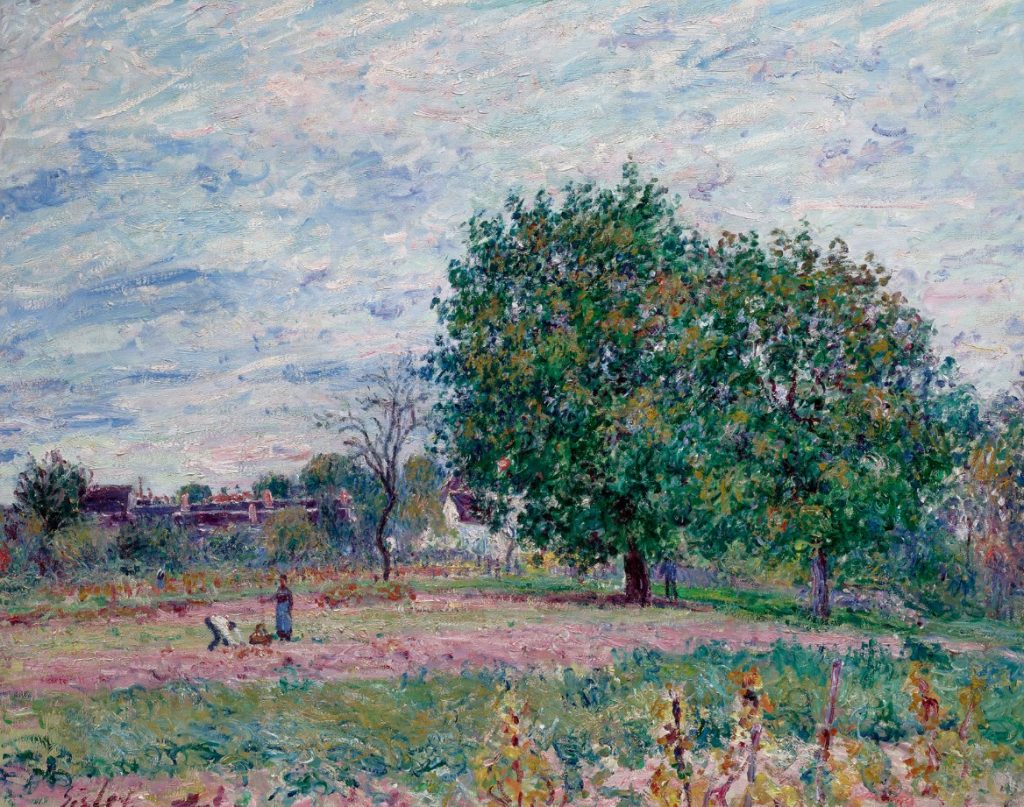
Lot 58
Alfred Sisley
Les Noyers, Effet de Soleil Couchant – Premiers Hours d’Octobre
Estimate: $1,500,000-$2,000,000
Impressionist & Modern Art Day Sale
Sotheby’s New York (4 Lots)
November 13, 2018
Lot 149
Henri Fantin-Latour
Roses
Estimate: $250,000-$350,000
Lot 150
Henri Fantin-Latour
Pommes
Estimate: $400,000-$600,000
Lot 151
Alfred Sisley
La Seine au Point du Jour
Estimate: $700,000-$1,000,000
OUR SERVICES
Offering expert Advisory across sectors, our dedicated Advisory and Sales Agency teams combine strategic insight with transparent advice to guide our clients seamlessly through the market. We always welcome the opportunity to discuss our strategies and services in depth.
Impressionist & Modern Art Day Sale at Sotheby’s
FEATURING THE GILDED AGE REVISITED: PROPERTY OF A DISTINGUISHED AMERICAN COLLECTION
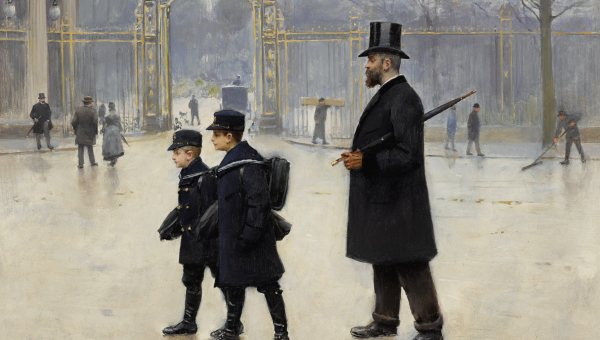
Jean Béraud (French, 1849-1935)LE PARC MONCEAUSigned Jean Bèraud and dated Xbre 1887 (lower right)
Painted in October 1887
Oil on panel
9 1/8 by 12 7/8 in. (23.2 by 32.7 cm)
Estimate: $150,000-$200,000
PROVENANCE
Madame H. Antoine-May (acquired by 1933)
Sale: Hôtel Drouot, Paris, March 18, 1983, lot 21
Richard Green Fine Paintings, Ltd., London
Acquired from the above.
EXHIBITED
Paris, Exposition du Cercle de l’Union artistique, 1888, n.n.
Paris, L’Union interalliée, Exposition des cent portraits, 1922, no. 13 (titled Portrait de M.A.M. et de ses fils)
Paris, Palais du Louvre, Pavillon de Marsan, Le Décor de la vie sous la IIIe République de 1870 à 1900, 1933, no. 23 (titled Monsieur Antoine-May et ses fils)
Paris, Musée Carnavalet, Jean Béraud, Peintre de la vie parisienne, 1936-37, no. 23, illustrated in the catalogue (titled Portrait de M. Antoine-May et de ses fils (Devant la grille du parc Monceau))
London, Richard Green Fine Paintings, Ltd., Exhibition of 19th and 20th Century French Paintings, 1983, no. 2, illustrated in the catalogue
LITERATURE
“Les Expositions des Cercles,” in L’Artiste, 1888, vol. CXXVII, no. 1, p. 190
“Les Oeuvres et les Hommes,” in Le Correspondant, Paris, 1888, vol. 150, p. 728
Auguste Dalligny, “L’Exposition du Cercle de l’Union artistique,” in Le Journal des arts, February 14-17, 1888, p. 1
Ernest Hoschedé, “Exposition de l’Union Artistique,” in L’Événement, February 15, 1888, p. 3
Paul Mantz, “Exposition du Cercle de l’Union artistique,” in Le Temps, February 28, 1888, p. 3
Louis de Fourcaud, “À travers les expositions,” in La Revue illustrée, April 1, 1888, pp. 247-48, illustrated p. 245
Patrick Offenstadt, Jean Béraud 1849-1935, The Belle Époque: A Dream of Times Gone By, Catalogue Raisonné, Cologne, 1999, no. 5, illustrated p. 89
OUR SERVICES
Offering expert Advisory across sectors, our dedicated Advisory and Sales Agency teams combine strategic insight with transparent advice to guide our clients seamlessly through the market. We always welcome the opportunity to discuss our strategies and services in depth.
Over the next five months, each of our executives – Anita Heriot, President, Roxanne Cohen, Director of Art Advisory, Kerry-Lee Jeffery, Director of Consignment, Colleen Boyle, Director of Sales, Kate Molets, Director of Appraisals – will focus on some of the ways we embrace independence, transparency and expertise to bring the best service to our clients. We will be exploring the importance of choosing the right auction house for the sale of our client’s objects, understanding appraisal values, art financing, Philanthropic strategy and acquisition due diligence as key components in working as a fiduciary on behalf of our clients and institutions.
WHAT IS A TANGIBLE ASSET FIDUCIARY?
The word Fiduciary evolved out of the Latin Fidere, to trust. In order to truly act on behalf of a client’s interest trust needs to be the bedrock of the relationship. A tangible asset fiduciary has no “skin in the game”; the focus of our work is the valuable objects in a client’s collection. Our approach is independency and transparency. This essentially means that every action we take and every strategy we propose is directly in the best interest on the objects and the clients that own them. The client trusts us to represent them.
TOPIC #1: CHOOSING THE RIGHT AUCTION HOUSE
When contracted with assisting a client with the sale of a single work of art, an entire collection, or other valuable objects; our responsibilities include making it an effortless and transparent process, negotiating all commissions and fees, facilitating all logistics and most importantly maximizing the return.
The initial step when first approached by a client who is looking to monetize a work is to determine the most appropriate method and market for sale. Certain works can and should be sold privately, while others would benefit from a more competitive market by being sold through specialized sale at auction. While most regional and national auction houses will have Fine Art Departments, only a select few will have specialized sales that target the right collectors for a particular work. These specialized sales include more thematic categories like the annual ‘Orientalist Sale’ at Sotheby’s in London or Copley Fine Art’s bi-annual ‘Sporting Sale’, or regional specializations such as Freeman’s bi-annual Pennsylvania Impressionists sale, or Leslie Hindman’s ‘Made in Chicago’ sale.
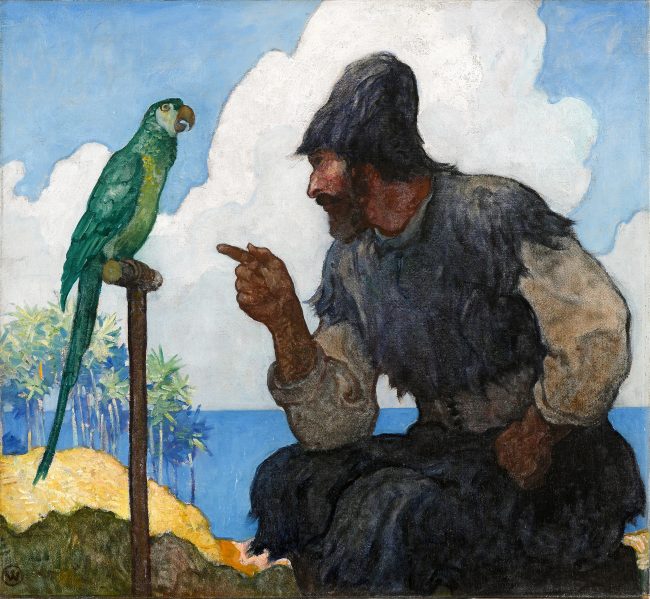
A further layer to this specialized approach is when a particular auction venue has cornered the market, so to speak, for a particular artist. A little known artist is Ida Rittenberg Kohlmeyer, a Louisiana based abstract artist who studied and was influenced by Hans Hoffmann. Kohlmeyer is predominately collected in the south, with 288 records at auction, 216 of those are split between two New Orleans based auction houses that also hold the record prices for the artist. Examining the sales records for this particular artist shows that the best results, save for one or two outliers, are when works have sold at one of those two venues. An even more compelling example is that of Boris Vallejo, a Peruvian born illustration artist, with 224 records at auction and a staggering 210 of those at Heritage Auction House! We recently assisted a client in Pennsylvania with an illustration work by Vallejo. The value was fairly modest and most may think special consideration need not apply. However, based on the results for Vallejo at Heritage, where there is a considerable interest for the artist’s work in their illustration sales, the work sold for ten times the estimate – and set a world record for the artist! This is a result that would not have been achieved had the work been sold in a more general paintings sale at a regional house.
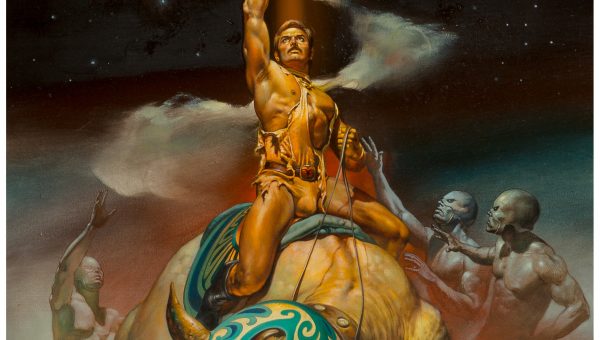
We assisted a West Coast based client with the sale of a modern Chinese work by famed artist Xu Beihong. While works by this artist have sold in New York and London, the most successful results have always been achieved in Hong Kong. In this particular case, the work soared past its estimate of $400,000-$600,000. A result that would not necessarily have been achieved had the work been sold in the United States where the work had been consistently estimated for under $100,000.
We utilize this same thought process when assisting with all tangible assets; including furniture and decorative arts, collectibles and other asset areas. For example, there are certain auction houses that specialize in 20th Century design, and in some cases, build the secondary market for a particular craftsman. The curated nature of the sales and specific marketing introduce works that had formerly no secondary market and generate a higher sale price. Other houses have a regional focus, like Leslie Hindman’s ‘Made in Chicago’ or a very focused specialty like Rago’s Modern Ceramics and Glass sales. When looking at larger traditional collections with varied contents and value levels we look to see where the overall collection will be best served as a possible ‘single owner sale’, pulling out specific pieces to be sold in specialized venues. Keeping more of the collection together allows for lesser or more moderately valued property to be marketed and cataloged in a better venue and allows for more competitive terms. Once the right venue placement has been identified we negotiate to ensure all fees are minimized or eliminated altogether. Auction houses can present a laundry list of fees; including seller’s commission, buy-in fees, insurance, catalogue fees, registrar fees, photography fees, storage fees, shipping fees etc. Based on the value of the overall consignment, these fees are always negotiable. In some cases, for highly desirable works, we negotiate to have the auction house *pay* our client a percentage from the buyer’s commission.

Another small, but very important aspect where we advocate on behalf of the client is in regards to marketing and catalogue placement. We need to ensure our client’s work is placed sequentially in the most advantageous place in the catalogue. I.e. if there are several works by the same artist or a very similar work, there is a strategy in place to which work comes first and last in the sequence as this can impact buyers’ spending. We would also work with the specialists to ensure other works are not consigned in for the same sale which would ‘compete’ directly with our clients’ work. We also work directly with the marketing departments to ensure our clients’ work or collection is given the utmost attention from a promotional standpoint, from basic advertisements, catalogue cover placement, signage, panels or lectures, cocktail events, traveling exhibits or luncheons.
The overall success of this bespoke service in placing works of art and other tangible assets in specialized sales is based ultimately on the fact that the auction venue has dedicated marketing and a focused clientele within reach for the specific work or item. Even with the full scope and reach of the internet and international bidding – choosing the right brick and mortar venue can be the difference between a work selling and a work selling well.
